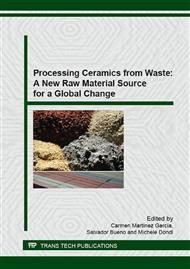[1]
Y. Liu, C. Lin, Y. Wu, Characterization of red mud derived of from a combined Bayer process and bauxite calcination method, J. Hazard. Mater. 146 (2007) 255–261.
DOI: 10.1016/j.jhazmat.2006.12.015
Google Scholar
[2]
M. Romero, A. Andrés, R. Alonso, J. Viguri, J.M. Rincón, Sintering behaviour of ceramic bodies from contaminated marine sediments, Ceram. Int. 34 (2008) 1917–(1924).
DOI: 10.1016/j.ceramint.2007.07.002
Google Scholar
[3]
N. Quijornaa, A. Coza, A. Andresa, C. Cheeseman, Recycling of Waelz slag and waste foundry sand in red clay bricks, Res. Con. Rec. 65 (2012) 1-10.
DOI: 10.1016/j.resconrec.2012.05.004
Google Scholar
[4]
M.J. Gázquez, J.P. Bolívar, R. García-Tenorio, F. Vaca, Physicochemical characterization of raw materials and co-products from the titanium dioxide industry, J. Hazard. Mater. 166 (2009) 1429–1440.
DOI: 10.1016/j.jhazmat.2008.12.067
Google Scholar
[5]
M.J. Gázquez, J. Mantero, J.P. Bolívar, Physico-chemical and radioactive characterization of TiO2 undissolved mud for its valorization, J. Hazard. Mater. 191 (2011) 269–276.
DOI: 10.1016/j.jhazmat.2011.04.075
Google Scholar
[6]
UNSCEAR: Sources, effects and risks of ionizing radiation. Report to the General Assembly, with annexes. United Nations, New York, (1988).
DOI: 10.18356/55345362-en
Google Scholar
[7]
L. Pérez-Villarejo, D. Eliche-Quesada, F. J. Iglesias-Godino, C. Martínez-García, F. A. Corpas-Iglesias, Recycling of ash from biomass incinerator in clay matrix to produce ceramic bricks. J. Environ. Manage. 95 (2012) S349-S354.
DOI: 10.1016/j.jenvman.2010.10.022
Google Scholar
[8]
M.J. Gázquez, Characterization and recovery of waste generated in the industry for the production of titanium dioxide (Caracterización y valorización de residuos generados en la industria de producción de dióxido de titanio). University of Huelva. (2010).
Google Scholar
[9]
M. Dondi, C. Zanelli, M. Raimondo, G. Guarini, D. Dalle Fabbriche, A. Agostini, Recycling titania slag insolute residue (Tionite, ) in clay bricks. Ceram. Int., 36 (2010) 2461-2467.
DOI: 10.1016/j.ceramint.2010.08.007
Google Scholar
[10]
W. Hajjaji, G. Costa, C. Zanelli, M.J. Ribeiro, M.P. Seabra, M. Dondi, J.A. Labrincha, An overview of using solid wastes for pigment industry. J. Am. Ceram. Soc., 32 (2012) 753-764.
DOI: 10.1016/j.jeurceramsoc.2011.10.018
Google Scholar
[11]
M. Contreras, M.J. Gázquez, I. García-Díaz, F.J. Alguacil, F.A. López, J.P. Bolívar, Valorization of ilmenite mud waste for the manufacturing of Sulfur polymer cements, J. Environ. Manage. 128 (2013) 625-630.
DOI: 10.1016/j.jenvman.2013.06.015
Google Scholar
[12]
ISO 10545-3: 1997, Ceramic tiles. Part 3: Determination of water absorption, apparent porosity, apparent relative density and bulk density.
DOI: 10.3403/30321734
Google Scholar
[13]
ASTM C373-88: 1999, Standard test method for water adsorption, bulk density, apparent porosity and apparent specific gravity of fired whiteware products.
DOI: 10.1520/c0373-88r06
Google Scholar
[14]
EN 843-1: 2006, Advanced technical ceramics. Monolithic ceramics. Mechanical properties at room temperature. Part. I: Determination of flexural strength.
DOI: 10.3403/00483134u
Google Scholar
[15]
R.L. Lozano, J.P. Bolívar, E.G. San Miguel, R. García-Tenorio, M.J. Gázquez, An accurate method to measure alpha-emitting natural radionuclides in atmospheric filters: application in two NORM industries, Nucl. Instrum. Meth. A. 659 (2011).
DOI: 10.1016/j.nima.2011.08.006
Google Scholar
[16]
U.S. EPA, Test Methods for Evaluating Solid Waste Physical Chemical Methods, SW-846, U.S. Environmental Protection Agency, Washington, DC, (1997).
Google Scholar
[17]
T. Chernet, Applied mineralogical studies on Australian sand ilmenite concentrate with special reference to its behaviour in the sulphate process, Min. Eng. 12 (1999) 485-495.
DOI: 10.1016/s0892-6875(99)00035-7
Google Scholar
[18]
J. Martín-Márquez, J. Ma. Rincón, M. Romero, Effect of microstructure on mechanical properties of porcelain stoneware, J. Am. Ceram. Soc. 30 (2010) 3063–3069.
DOI: 10.1016/j.jeurceramsoc.2010.07.015
Google Scholar
[19]
J. Martín-Márquez, J. Ma. Rincón, M. Romero, Effect of firing temperature on sintering of porcelain stoneware tiles, Ceram. Int. 34 (2008) 1867–1873.
DOI: 10.1016/j.ceramint.2007.06.006
Google Scholar
[20]
J. Martín-Márquez, A.G. De la Torre, M.A.G.; Aranda, J. Ma. Rincón, M. Romero, Evolution with temperature of crystalline and amorphous phases in porcelain stoneware, J. Am. Ceram. Soc. 92 (2009) 229–34.
DOI: 10.1111/j.1551-2916.2008.02862.x
Google Scholar
[21]
L.A. Pérez-Maqueda, V. Balek, J. Poyato, J.L. J. Pérez-Rodríquez, Šubrt, I.M. Bountsewa, I.N. Beckman, Z. Málek, Study of natural and ion exchanged vermiculite by emanation thermal analysis, TG, DTA AND XRD, J. Therm. Anal. Calorim. 71 (2003).
DOI: 10.1007/s10973-005-7462-5
Google Scholar
[22]
S.M. Pérez-Moreno, M.J. Gázquez, A.G. Barneto, J.P. Bolívar, Thermal characterization of new fire insulating materials obtained from industrial inorganic wastes from TiO2 industry, Thermochim. Acta. 552 (2013) 114-122.
DOI: 10.1016/j.tca.2012.10.021
Google Scholar
[23]
A. De Noni, D. Hotza, V. Cantavella, E. Sanchez. Effect of quartz particle size on the mechanical behaviour of porcelain tile subjected to different cooling rates. J. Eur. Ceram. Soc. 29 (2009) 1039–1046.
DOI: 10.1016/j.jeurceramsoc.2008.07.052
Google Scholar
[24]
EN 14411: 2003, Ceramic tiles. Definitions, clasifications, characteristics and marking.
Google Scholar
[25]
Office European Comission Report on Radiological Protection - Principles concerning the natural radioactivity of building materials, Radiation Protection 112, for Official Publications of the European Communities, Luxembourg, (1999).
Google Scholar
[26]
H. Mabuchi, On the volatility of some polonium, J. Inorg. Nucl. Chem. 25 (1963) 657-660.
Google Scholar
[27]
K. Kovler, Radiological constraints of using building materials and industrial by-products, Constr. Build. Mater. 23 (2009) 246-253.
DOI: 10.1016/j.conbuildmat.2007.12.010
Google Scholar
[28]
A. Hierro, J.E. Martín, M. Olías, C. García, J.P. Bolivar, Uranium behaviour during a tidal cycle in an estuarine system affected by acid mine drainage, Chem. Geo. 342 (2013) 110-118.
DOI: 10.1016/j.chemgeo.2013.01.021
Google Scholar
[29]
U.S. EPA, Test Methods for Evaluating Solid Waste - Physical Chemical Methods, SW-846, U.S. Environmental Protection Agency, Washington, DC, (1997).
Google Scholar


